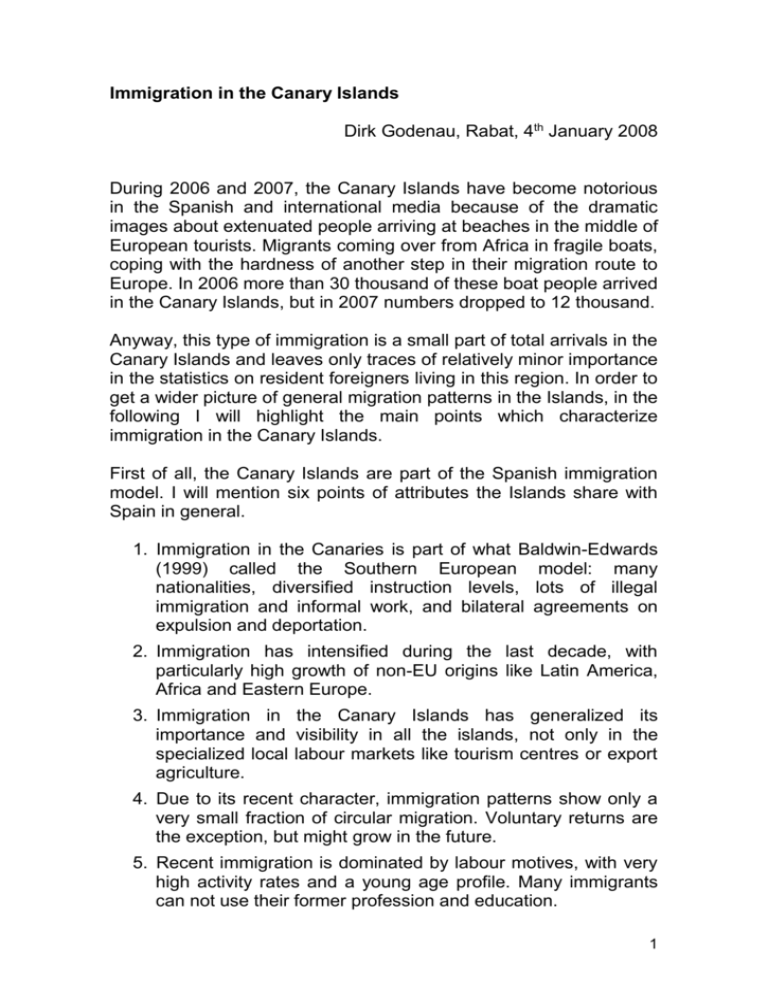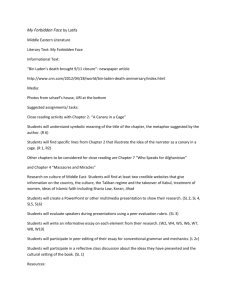Immigration in the Canary Islands
advertisement

Immigration in the Canary Islands Dirk Godenau, Rabat, 4th January 2008 During 2006 and 2007, the Canary Islands have become notorious in the Spanish and international media because of the dramatic images about extenuated people arriving at beaches in the middle of European tourists. Migrants coming over from Africa in fragile boats, coping with the hardness of another step in their migration route to Europe. In 2006 more than 30 thousand of these boat people arrived in the Canary Islands, but in 2007 numbers dropped to 12 thousand. Anyway, this type of immigration is a small part of total arrivals in the Canary Islands and leaves only traces of relatively minor importance in the statistics on resident foreigners living in this region. In order to get a wider picture of general migration patterns in the Islands, in the following I will highlight the main points which characterize immigration in the Canary Islands. First of all, the Canary Islands are part of the Spanish immigration model. I will mention six points of attributes the Islands share with Spain in general. 1. Immigration in the Canaries is part of what Baldwin-Edwards (1999) called the Southern European model: many nationalities, diversified instruction levels, lots of illegal immigration and informal work, and bilateral agreements on expulsion and deportation. 2. Immigration has intensified during the last decade, with particularly high growth of non-EU origins like Latin America, Africa and Eastern Europe. 3. Immigration in the Canary Islands has generalized its importance and visibility in all the islands, not only in the specialized local labour markets like tourism centres or export agriculture. 4. Due to its recent character, immigration patterns show only a very small fraction of circular migration. Voluntary returns are the exception, but might grow in the future. 5. Recent immigration is dominated by labour motives, with very high activity rates and a young age profile. Many immigrants can not use their former profession and education. 1 6. Immigrants’ work is concentrated in a few occupational niches, with horizontal and vertical stratification. Hard work, low salaries. Apart from educational and gender differences, we observe ethno-stratification. Despite these aspects the Canary Islands have in common with the Spanish case, there are also some specific traits we may point out: 1. In historical terms, the Islands always have been a very open little economy and society, which a demographic regime characterized by high mobility rates. The Canary Islands never have been an isolated place and are used to grow on location economies which derive from their geo-strategic position between three continents. For example, Columbus stopped at the Canary Islands before going to America. 2. The Canaries have become more important as a point of entry for illegal African immigration in the European Union. The reduction of border permeability in the Mediterranean, combined with changes in the intra-African migration system, increased the relative attraction the Islands have as a transit point. Present initiatives dedicated to increase border control in the Atlantic may alter this situation in the next years. 3. The Canary Islands are one of the Spanish regions with lots of European immigrants, particularly English and Germans, who appreciate the natural conditions for their retirement or work in the service sector, particularly in tourism. 4. Due to the substantial emigration flows to Cuba and Venezuela, the Canary Islands maintain migration chains and networks with these former destinations. In the second half of the 20th century, return migration dominated the non-European immigration flows in the Islands. At present, immigration from Venezuela is still more important in the Canary Islands than on the Spanish mainland. 5. Economic specialization in tourism induces selective effects in the composition of immigration flows. Labour demand expanded heavily during the present growth cycle, especially in lower instruction levels, in the secondary segment and the informal economy. This labour demand is very elastic with respect to changes in economic cycles. 6. The sex ratio of immigration in the Canary Islands is relatively low, due to the importance of Latin American and European 2 origins and the local economic structure. Tourism and domestic services are among the more important occupations female immigrants will find in this region. Once we have got the general picture, we may now proceed to focus on the irregular African migration arriving in the Canary Islands by boat. Again I will concentrate on the main facts and afterwards we can go into details if you wish. 1. The Canaries are islands located on the Southern border of the European Union. This part of the European border has to be crossed by plane or boat; you cannot travel easily to other parts of Europe without documentation. In principle, that lowers the attractiveness for transit migration, at least if interception and deportation probabilities are high. 2. Only a very limited fraction (maximum 5%) of irregular migrants living in the Canary Islands came over from Africa without documentation and by boat. Most irregular migrants arrived with tourist visas and overstayed these permits afterwards. This part of regular entry combined with irregular staying only may be reduced by internal control mechanisms and these have low intensity in Spain. 3. The composition of illegal maritime African immigration in the Canary Islands has changed over the years. The Northern African origins, very important 10 years ago, are nowadays less important. The black immigration from Southern-Western African countries has become dominant. At the same time, origins got more diversified and include nowadays some transAfrican migrants from Asia. 4. Another change is the growing importance of the so-called Menores No Acompañados, younger people who have not reached a stage of adulthood defined by European standards. These migrants less than 18 years old came to work, cannot be deported and have to be retained for their “protection”. At the moment, about 1.200 young African migrants are retained in so-called “Centros de Acogida de Menores” and the regional government, competent institution in this issue, has started to subcontract NGOs located in the Spanish mainland and demands more help from the national government. 5. The increasing collaboration between Spain and some the African states in the interception in origin or transit, has altered migration routes. The boats get bigger (“cayucos” instead of 3 “pateras”), the travel time gets longer and more dangerous, and the arrival points are no longer selected by reason of geographical proximity. Now Tenerife and Gran Canaria are the main arrival points and Fuerteventura and Lanzarote are less important. Technology is of increasing importance (GPS, mobile phones). 6. The perception of immigration in the Canary Islands has changed during the last years. At present, many people perceive immigration as a threat. About two thirds of the local population think there are too many foreigners in the Islands. These fears are not simply endogenous, as some politic parties, the present nationalistic government and part of the media produce and communicate negative messages on the issue. Although the highly visible black immigrants do not stay in the Canary Islands, because nearly all of them are taken to the mainland, the published image of immigration is the cayuco arriving at the beach. 7. Knowing that you should not call other people “inferior” or “unworthy”, the dominant political discourse in the Canary Islands is shifting gradually towards a different argument: the lack of carrying capacity. With a high population density, a supposedly fragile environment, and the ultra-peripheral position certified by the European Union, the government systematically talks about over-population and asks for more population control measures. The advantage of this type of argument is simple: “it’s nothing personal, it’s not we do not like you, simply there is no space you can sit down”. 8. If we look at the policies of reception and integration of immigrants in the Canary Islands, we face two problems regarding African origins. Number one, the canarian economy and society have lived completely isolated from African reality. There are no links you can build on and to most people Africa only means exotic beauty and extreme poverty. Number two, local integration policies are weak in the Canary Islands. Apart from demanding that the central government in Madrid should do everything necessary to stop immigration, little attention is given to developing useful tools for integration and migration management. As a consequence, social empowerment of immigrants depends exclusively on NGOs and immigrant organizations. 4 I would like to finish this short note by posing some hypotheses which might be useful for the following debate. 1. After 10 years of intensification, during the next years immigration intensity will drop in Spain, in general, and in the Canary Islands, in particular. We already see the first economic hints. Employment in construction and services is no longer growing at high rates and the economy of the Canary Islands is always reacting quicker and stronger than the Spanish mainland to exogenous shocks and changes in business cycles. That causes effects in migration. The share the Canary Islands have in the total foreign population in Spain has fallen from more than 8 points in 1998 to 5.6 points in 2007. 2. We will see more return migration, circular migration and family reunification in the next years. Both ingoing and outgoing flows will be more selective and the South American origins should lower their participation in new immigration flows. 3. Although we might be able to reduce irregular migration and increase regular flows, labour exploitation will not cease if we do not do anything against the large informal economy through more internal control. Anyway, increasing labour market inspection not only affects immigrants. 4. As I said before, the Canary Islands are, in principle, not very attractive for irregular transit migration, because interception probabilities are high. If the relative permeability of this part of the Southern European border will be forced downwards, the relative attractiveness of alternative routes will improve and the quota of the route through the Canary Islands will be back to normal. 5. Regarding perceptions, lower economic growth rates will bring more unemployment. Official representatives of the regional government already tell people through the media that immigration is behind the rising unemployment rates in the Canary Islands. As always, people will be happy to accept this scapegoat and employment opportunities open to immigrants may drop dramatically. 5






